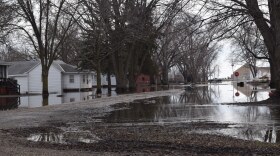Several southwest Iowa communities are still battling historic flooding and people remain displaced from their homes.
One of those people is Matt Schoville. He and his family have been out of their home just south of Percival for almost two weeks. They’ve been staying at a campground outside of Sidney. Schoville said it’s been devastating being displaced from their home.
“I really don’t know what we’re going to do, it’s crazy,” Schoville said. “There’s not much to rent or to buy around this area, to even relocate for now. But I don't want my kids not to go to school in this area, because I don't want to move them again."
When the family of six left their home, they took their cats, five goats and three dogs, but they had to leave behind their chickens. Four days after flooding started to affect the town, they took a boat back home and found all their chickens were dead.
Schoville called the scene around his home “pretty unreal.” He bought his home in December 2017, gutted it completely and spent almost a year remodeling it.
“I spent my life savings just redoing this house for my family so I could retire there and put the kids through college…just to lose it,” Schoville said.
Across Fremont County, part of Hamburg remains evacuated and Percival, McPaul and Bartlett are fully evacuated. Bartlett has been evacuated for two weeks.
Fremont County Emergency Management Coordinator Mike Crecelius said the county is in devastation.
“Bartlett in 2011 only had 3 to 4 feet of water in it and this time Bartlett had water to where you could only see rooftops,” Crecelius said.
Crecelius said there are 14 levee breaches in the county and he’s concerned.
“I don’t see how the [U.S. Army] Corps of Engineers is going to be able to fill every breach from Missouri Valley, Ia. to St. Joe, Mo. before the spring thaw,” he said. “I believe that we’re going to have flooding issues out there spring, summer and right into the fall.”
The Federal Emergency Management Agency is already in Fremont County starting to help people with individual assistance to recover from flooding. But Crecelius said the problems are far from over.
“Some of our county roads aren’t even there anymore,” he said. “There was that much force with the water flowing south that we have large portions of county roads that are missing or there’s holes in them.”
Crecelius said the Missouri River needs to drop below flood stage before communities can start to see relief. The Missouri River at Nebraska City, Neb. was recorded at 3 feet above minor flood stage on Thursday. Minor flood stage is 18 feet.
The river topped out at 30.15 feet on March 16 – 2 feet above the previous record from 2011.
The National Weather Service of Valley, Neb. says snowmelt from South Dakota is coming down the river and that’s one thing delaying water levels from dropping below flood stage. David Pearson, a senior service hydrologist, said the slow drop is “somewhat common.” Residual draining from the Platte and Elk Horn Rivers in Nebraska are adding to the slow drop in the river levels.
“For the most part, the large-scale flooding is diminishing, but the effects are still being felt,” Pearson said, “because some of that water that flooded places can’t get back to the river because it might be behind a levee or behind something else.”
Pearson continued, “It’s going to take time for all that water to completely move out.”





